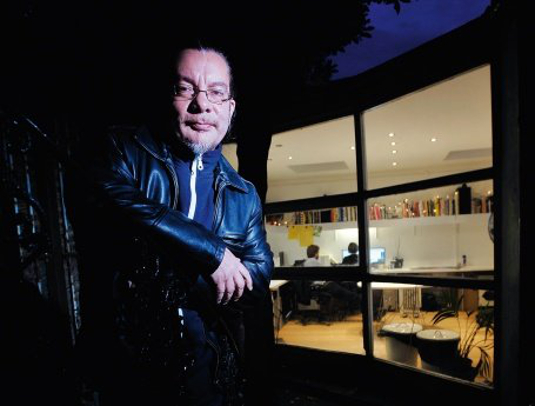Neville Brody on demolishing comfort zones
"The idea that the work you do could actually be of benefit to society... That just hit a brick wall called Thatcherism." Neville Brody demolishes design comfort zones with Graeme Aymer.

Your exhibition at Tokyo's Ginza Graphic Gallery has just come to a close. Can you tell us about it, and the accompanying book?
NB: Historically, we've done a lot of work in Japan. After I had the exhibition [in 1990/'91, following the 1988 publication of The Graphic Language of Neville Brody] in London, the exhibition then went to Germany and toured Japan, and we've done a lot of work there for different clients. We're going there [to exhibit this time] partly to try and reinvigorate getting work in Japan as a British company.
Japan is so faddish. You can be in demand for a few weeks, and then there's a new flavour. So, in a way, what we're trying to do is to have a chance to readdress that. There's a series of books published by Dai Nippon; they have two galleries, one of which is a place called GGG, the Ginza Graphic Gallery, in Tokyo. They have a lot of exhibitions with which they have also been publishing a series of Ladybird book-sized books for a number of years. The books are basically biographies of different graphic designers, and I'm the first English graphic designer that they've done in this series of, like, 60 or 70. They're wonderful little books.
In terms of Research Studios, what is your role these days?
NB: It's all changing. I think there have been three phases: the first was doing all of the creative work and working with assistants; the second was much more running it as a business in the sense of nurturing the design team, nurturing young designers, letting them grow - that was a little bit of a shift, when we changed the name to Research Studios to shift away from me so that the clients wouldn't expect me on every project, and the designers here could feel responsible, take ownership; the third phase is me starting to develop a lot of my own work again. We've got a lot of new ideas coming through in 2009. We're going to redo the FUSE conference for 2010, so in 2009 you're going to see a series of different events based around it. And there's another thing that's happened: it's been 25 years of cultural deep freeze, basically.
With that in mind, are you finding exciting design around?
NB: No. Absolutely none.
None at all?
NB: When was the last time you saw some exciting design, truly exciting design? I did a talk last month at Le Book's Connections event, and the theme I picked up on was dangerous images. I drew a line that started in Dadaism, Futurism, went through John Heartfield and people like Richard Hamilton, Malcolm Kennard and Jamie Reid, and then to the French punk graphic scene until, effectively, 1983, which was when Reaganism and Thatcherism came into its prime and the curtain was drawn on radical culture - radical culture and the idea that culture or art was about helping society to improve itself, that the work you do could actually be of benefit to society. That just hit a brick wall called Thatcherism.
Did we get greedy?
NB: No, it wasn't greed. It was really so clever. She successfully restated that culture wasn't there to make you think. It was there to make you shop. That was a watershed moment.
Watching that happen, how does it make you feel?
NB: You get caught up in it! The brainwashing is so successful. You lose sight. Part of what we're looking at in 2009 is how culture has changed by the words we don't use anymore, the phrases. In the 1970s and 1960s they were 'Ban the Bomb', 'People Power' or 'Uprising' or ... 'Progress'. When did you last hear the word 'Progress'?
Has technology made it too easy for people to call themselves 'designers'?
NB: You could buy a pencil and a piece of paper for 10p before. What's the difference? Designers are going through college now - a guy I used to work with on Actuel magazine, Jean-François Bizot, said it's the comfort and prestige generation - they're not looking for design that's going to shock the world unless it can reinforce those two values.
I've asked designers, "What do you want to do?" and they say, "I want to make design that my peers will like." And I've said, "But why?" [And they respond,] "So that they like my work, because I want them to recognise that I'm a good designer". There's no social contextualising at all going on. It's about income and exposure.
Might that change?
NB: Well, the collapse of the economy does two things: it says that you're not guaranteed that [income and exposure] anymore; and suddenly there's a window of opportunity - I think the deep freeze has thawed. I don't know if it's going to thaw for a long time, but right now there's a window of opportunity. It needs people to recognise it, to start key things happening again and taking risks. It's about doing something that's going to re-engage people, re-engage culture and society, and re-engage possibility.
How about Research Studios: what's happening with the studio?
NB: We're still working with clients, and 5-10% UK billing, which has been the same since I had the exhibition here.
Where does the rest come from?
NB: Everywhere else, just not in the UK. For some reason we suffered far more in the UK than anywhere [due to the economic downturn]. I say suffered - at the beginning it was a real pain. But it's been a godsend in a way, because we've been allowed creative possibility.
Does the UK find Research Studios intimidating?
NB: People just have to look at the work we do - we're a professional studio: Dom Perignon trusts us to help them rebrand, then we've been working with big hotel companies and Kenzo, of course. In Germany, the studio has been working with Bugatti and Lamborghini. Here [in the UK] we get work from consular institutes, like we're doing a lot of work for the Barbican. Then, of course, we did the Somerset House brand and the D&AD book. And we redesigned The Times!
What was that like to do?
NB: Brilliant. It was great: over a year-and-a-half of doing something that didn't look different.
Can you say that?
NB: Yes, that was their brief. They said: we need to change the paper completely - as long as no-one notices. That was a real challenge. We introduced mechanisms to help them express the content better, to increase the drama of how to tell stories, structuring it so they could connect more than one story together in a more successful way, looked at the headline font, redesigned that better for the paper and for the size and for economy of lettering - everything. There were, like, 200 to 300 changes we made.
It went from broadsheet to tabloid, so instead of a feature taking half a page or three-quarters of a page at broadsheet size, it would take three or four pages at tabloid. So we helped them organise increased entry points, better signage systems - we stripped the whole thing out and then rebuilt it, so it's like the same car but with a new engine.
How do you feel about being labelled a 'design icon'?
NB: It's a publicly owned statement, nothing to do with me as a person. You can't even think about that. You don't wake up in the morning and say, 'Hey! I'm a design icon! What shall I do today?' You're finished if you do that! Imagine!
Every art college I ever visit teaches my work to the students, but I've just re-enrolled for beginners' life drawing at St Martins. I'm not that good at drawing - I've always been on the edge of being all right at drawing but forgetting how to do it, so it's like I've got stuck in this loop. But it's so much fun. I love it.
So that's more where I am. It doesn't make me Sir Plumber. I'm still Plumber.

Thank you for reading 5 articles this month* Join now for unlimited access
Enjoy your first month for just £1 / $1 / €1
*Read 5 free articles per month without a subscription

Join now for unlimited access
Try first month for just £1 / $1 / €1
Get the Creative Bloq Newsletter
Daily design news, reviews, how-tos and more, as picked by the editors.

The Creative Bloq team is made up of a group of design fans, and has changed and evolved since Creative Bloq began back in 2012. The current website team consists of eight full-time members of staff: Editor Georgia Coggan, Deputy Editor Rosie Hilder, Ecommerce Editor Beren Neale, Senior News Editor Daniel Piper, Editor, Digital Art and 3D Ian Dean, Tech Reviews Editor Erlingur Einarsson, Ecommerce Writer Beth Nicholls and Staff Writer Natalie Fear, as well as a roster of freelancers from around the world. The ImagineFX magazine team also pitch in, ensuring that content from leading digital art publication ImagineFX is represented on Creative Bloq.
